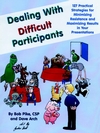
This picture was taken during the dessert safarai trip in Dubai last November. The trip turned out to be much more exciting (and tough!!) than I expected. Before the trip, I was expecting those kind of gentle safarai where you 'cruise' within a jungle and see some animals. But it was actually like sitting in a driving test for the Toyota Land Cruiser 4x4!! Well, despite all the 'bumpy' moments, the trip was nice - enjoying the sunset in the middle of the dessert was definitely a new experience to me!!
So much about the safarai - let me share with you some of my facilitation learnings in Dubai. I was in Dubai to deliver a
SPIN class. I looked forward very much to this trip since it was the first I deliver a class outside Asia. And it did turn out to be an excellent learning experience for myself (and hopefully for the participants as well!) Let me tell you more.
There are a lot of activities in
SPIN class (something which I like the class a lot), and of course I need to give lot of instructions. To my surprise, I received lot of puzzled faces and questions asking for clarification - much more than I expected. Whilst it was partly owing to the different accents, it was also partly because of clarity of my instruction.
I have been thinking that I was clear in telling. In the past, I have received various feedbacks that relative to the others I am structured, slow and sensitive enough to pass clear message. In the training context, for example, I believed that my instructions for class activities were clear enough. But I realised that I should do it better. The Dubai experience told me that I was sometimes too quick and brief in giving my instructions. I believe I did not realise such area for improvement before because my participants in Asia were more reserved in 'challenging' me.
Working under confusing instructions is frustrating. Remember the last time when you were a participant e.g. when the instructor said 'We will now have a small group activity. Now form yourself into small groups with 3 people each.' People then were left with silence. You will feel embarassed cos if you choose someone, you do not know whether they like it or not. And more importantly, it means you abandon someone else, especially those originially sitting next to you. Normally, what happened at the end was that the small groups composed those sitting next to each other.
Now, I always tell myself the following when I give instruction:
Specific - You really have to. Take the previous example, instead of forming the groups themselves, you better do a '1, 2, 3, 1, 2, 3...' or 'month of birth' kind of team allocation. In addition, you will tell each group where they will conduct their small group activities e.g. the small table over there!!
Another example - You want them to learn from their previous experience with good and bad presenters around them. Some instructors will say 'Now, in your group, share with each other your experience with good and bad presenters'. A better instruction would be 'Now, in your group, each of you will tell the others one good presenter and one bad presenter you have met. After telling the others about the occasion, tell also the others what the presenters have done or not done which make him / her a good / bad presenter'
Show them the sample deliverables - Even for simple exercise. Say, for the presentation exercise above, assuming that you want them to present group learning after small group discussion. Some instructors will say as well '.... after your sharing in the group, I will ask you to present with the bigger group.' For a better instruction, you will draw on a flipchart the sample output you expected e.g. dividing the flipchart into 2 columns, for good and bad behavior respectively, and you will write an example under 'good behavior' e.g. eye contact. You will also say 'this flipchart will be what you come up with at the end of your group discussion so that you can use as visual aid to present your sharing to the bigger group.' And you will remind by saying 'I however do not expect a laundry list of DO and DONT. Please thus do first tell the others your real experience, and then add on the flipchart about what the presenter has done / not done'.
Written instruction - Always help even for simple activities. For example, you run an energizer asking them to draw 4 consecutive straight lines to join 9 dots. Do write on the flipchart '4 consecutive straight lines', cos there is always someone who did not listen to you as they are thinking about something else... their work, their kids, their dinner... or as they are 'recovering 'from lunch!!
Slowwwww - It also means you need to repeat it. If you feel that the participants are not listening enough, you should even ask someone to repeat your instruction!!! Telling slowing is especially when you are delivering outside your own countries - not everyone can follow your accent easily!!
So, thanks to the participants in Dubai which told me more about my instruction-giving capability. (And I did love the participants - very participative, lovely and friendly. I was a bit worried about outspoken participants in the beginning but it did turn to be a great experience. I even slightly thought of working there!!!). And my another learning is that facilitating in other countries will help you to sharpen your facilitation skills!!! It is like sports - you will know more about your strength and weakness as you play with different players!!









